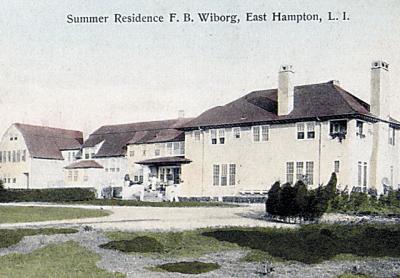Grandest of the Grand: Summer Residence of F.B. Wiborg

If you ever wondered what the grandest house in East Hampton was a century ago, then Frank B. Wiborg’s the Dunes would be a top contender. The house once overlooked what is now called Wiborg’s Beach, making the name chosen for the summer home very appropriate.
But who was this Wiborg? Frank Bestow Wiborg was born in Cleveland in 1855 to a Norwegian immigrant named Henry Paulinus Wiborg and his wife, Susan Isidora Bestow. Frank attended the prestigious Chickering Scientific and Classical Institute and supported himself through school by selling newspapers. After graduation, he went to work for Levi Ault, who sold printing ink. Their relationship soon developed into a business partnership, and in 1878 they founded the Ault and Wiborg Company in Cincinnati, which would become a top producer and distributor of inks and lithograph supplies. By the time he was 40, Wiborg was a self-made millionaire with offices established across the country and around the world.
Originally summer vacationers, the Wiborg family rented rooms and cottages in Amagansett and East Hampton Village before purchasing property from Mrs. Marshall Smith in the spring of 1909. That summer, with the assistance of a prominent architect named Grosvenor Atterbury and George Eldredge, a builder, Wiborg had the pre-existing cottage overhauled and extended, making it possible for the family to move in by that September. However, construction would continue on the estate for the next few years.
Upon its completion, the Dunes, a 30-room stucco mansion, was considered the largest estate in East Hampton. It had a view of the ocean on one side and a view of the village on the other. The grounds also included a beautiful sunken Italian garden, stables, dairy barn, garages, a laundry house, and servants’ quarters.
In 1941, Sara Murphy — the Wiborgs’ eldest daughter, who had become famous in the 1920s as a literary inspiration for F. Scott Fitzgerald — found herself unable to sell or rent the mansion, and it was considered too expensive to maintain, so it was purposely burned down and demolished by the East Hampton Fire Department.
In 2012, papers were taken from Dune Flat (a.k.a. the Pink House), a former chauffeur’s cottage that was the last remaining structure of the Wiborg estate, and given to the Long Island Collection by the East Hampton Historical Society. Items from this collection are currently on display at the East Hampton Library, including postcards, correspondence, legal documents, invitations, and travel brochures.
Gina Piastuck is the department head of the Long Island Collection at the East Hampton Library.
